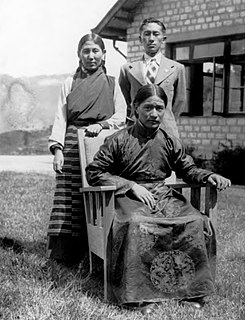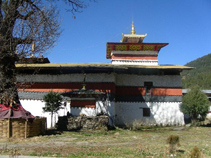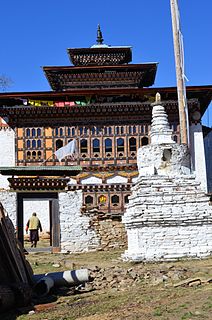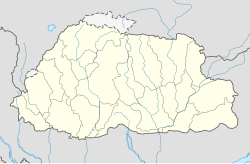Articles related to Bhutan include:

Buddha Dordenma is a gigantic Shakyamuni Buddha statue in the mountains of Bhutan celebrating the 60th anniversary of fourth king Jigme Singye Wangchuck. The statue houses over thousands smaller Buddha statues, each of which, like the Buddha Dordenma itself, are made of bronze and gilded in gold. The Buddha Dordenma is sited amidst the ruins of Kuensel Phodrang, the palace of Sherab Wangchuck, the thirteenth Desi Druk, overlooking the East Thimphu, the capital of Bhutan. Construction began in 2006 and was planned to finish in October 2010, however construction did not conclude until 25 September 2015. The completed work is one of the largest Buddha rupas in the world, at 54 metres (177 ft) and contains 8-inch and 12-inch-tall gold gilded bronze Buddhas.

Dudjom Jigdral Yeshe Dorje, was the second Dudjom Rinpoche. He was recognized as a direct rebirth of Dudjom Lingpa (1835–1904) and was also later appointed the first supreme head of the Nyingma lineage of Tibetan Buddhism by the fourteenth Dalai Lama and the Central Tibetan Administration.

Tamzhing Lhündrup Monastery in Bumthang District in central Bhutan is the most important Nyingma gompa in Bhutan. Its temple and monastery are remarkable for their direct connection to the Bhutanese tertön and saint, Pema Lingpa (1450-1521) and his tulkus. It is now the seat of Sungtrul Rinpoche, the current speech incarnation of Pema Lingpa.
Drukpa Kunley (1455–1529), also known as Kunga Legpai Zangpo, Drukpa Kunleg, and Kunga Legpa, the Madman of the Dragon Lineage, was a Buddhist monk and missionary in the Tibetan Mahamudra tradition, as well as a famous poet, and is often counted among the Nyönpa. After undergoing training in Ralung Monastery under siddha Pema Lingpa, he introduced Buddhism to Bhutan and established the monastery of Chimi Lhakhang there in 1499.

Tertön Sogyal Lerab Lingpa was a Tibetan Buddhist tertön and a teacher of the Thirteenth Dalai Lama.

The Gangteng Monastery ,generally known as Gangtey Gonpa or Gangtey Monastery, is an important monastery of Nyingmapa school of Buddhism, the main seat of the Pema Lingpa tradition. located in the Wangdue Phodrang District in central Bhutan. The Monastery, also known by the Gangten village that surrounds it, is in the Phobjikha Valley where winter visitors – the black-necked cranes – visit central Bhutan to roost, circling the monastery three times on arrival and repeating this circling when returning to Tibet. The Monastery's history traces to the early 17th century and back to the prophecies made by the well-known Terton Pema Lingpa in the late 15th century.
Thowadra Monastery is a cliffside Tibetan Buddhist monastery in the Tang Valley of Bumthang District, Bhutan. Thowadra means "high rock", given its location and altitude of 3,400 metres (11,200 ft).
Nyingma Gyubum is the Mahayoga, Anuyoga and Atiyoga Tantras of the Nyingma lineage.

Könchogsum Lhakhang, also known as Tsilung, is a Buddhist monastery in central Bhutan.

Lhuentse Dzong is a dzong and Buddhist monastery in Lhuntse District in eastern Bhutan. It lies on the eastern side of the Kuri Chhu and is perched on a spur at the end of a narrow valley.

Sobrang Monastery is a Buddhist monastery in Ura Gewog, Bhutan. It is one of the most important Bhutanese monasteries as descendants from its lineage include Pema Lingpa and hence the Wangchuck Royal family.

Ta Rimochan or Ti Rimochen is a Buddhist monastery in Bhutan belonging to the Nyingma school of Tibetan Buddhism. It is located near the village of Misethang in the Tang Valley east of Jakar. A stupa gate marks the road leading to it.
Yongla Monastery is a Nyingma Buddhist monastery in Pema Gatshel in Bhutan and is located at Yongloa on top of a mountain and is seen when one goes through the national highway linking Samdrup Jongkhar and Pema Gatshel. Although Yongla Goenpa was founded by Yongla Lam Dorji in 1736 but the monastery was originally founded by Kheydrup Jigme Kundel in the 18th century. Kheydrup Jigme Kundel was instructed by Jigme Lingpa to find a destination that resembled that of Tsari in Tibet which looked like a ritual dagger (Phurpa). This was a move to spread the teaching of Jigme Lingpa. Jigme Kuendel reportedly travelled from Tibet through Bumthang looking for the destined place until he reached the present day Yongla accompanied by Khandro Dechen Gyalmo. When he asked the Khandro if this was the place prophesied by his master, the Khandro said, ‘Yong Yong’, meaning ‘Yes, Yes’, thus the place was named Yongla. Jigme Kuendel then meditated in this place and spread his teachings and then built a meditation center at the place. A nunnery was also built at the same place due to increase in popularity of Kuendel's teaching. The Lhakhang that is seen now was built around the 1980s and a total of 16 successive Lams have served as the abbot of Yongla Gonpa.
Yonphula Lhakhang is a Buddhist monastery in Bhutan. It is situated in the Eastern District of Bhutan. The Lhakhang or monastery in Yonphula has been founded by Tantric Master Lama Karpo Rinpoche alias Lama Tshewang Penjor. He was the disciple of Tertoen Dudjom Lingpa Jigdrel Yeshi Dorji, who named him as Lama Karpo. Before he actually met with his karmic Master, Lama Karpo went to Tibet to learn and master the Tantric practices. There in Kongbu, Tibet, he has mastered and directed him by his master therefrom to visit his Karmic Master Dudjom Rinpoche. Lama Karpo Meditated in Paro Taktshang. While meditating in the cave, where Guru Rinpoche has meditated, from Guru's statue, he heard a clear voice. He was said to have astonished by this and felt himself in illusion. But, later he found to have talked to him by that very Guru Rinpoche's Statue. Subsequently, same Guru Statue voiced out to him for another time and during that time he did conversation with the statue. In later years, he went back to Trashigang and founded Yonphula Monastery. It is approximately 2700 meters above the sea level. It is few km away from the yonphula domestic airport. Currently, the abode is headed by Lama Jigme Tenzin, son of Lama Karpo. There are approximately 100 gomchens. They perform periodical rituals and other related religious rituals. There is a Meditation Center where many Gomchens do meditate for minimum of three years. After that, they are known to be tshampas or Yogi. They follow the Nyingma Tersar religion. It performs its annual Tshechu in the 10th day of 3rd month of Lunar calendar every year. It is called Trelda Tshechu.

Yagang Lhakhang, Mongar Bhutan.
Tsikey Chokling Rinpoche is a teacher, writer, religious ritual master, and meditation master of the Nyingma school of Tibetan Buddhism.

Membartsho is a holy site, revered as the place where Pema Lingpa, Bhutan's greatest tertön, discovered several of Guru Rinpoche's terma in the 15th century. The pool in the Tang Valley, near Bumthang in central Bhutan is known locally as the Burning Lake, because according to legend, Pema Lingpa had a dream urging him to go to that particular spot in the Tang Chuu river. After standing on the rocks looking into the depths he discerned there was a temple at the bottom with many doors, one of which was open. He dove in and swam into a large cave where a woman with one eye handed him a treasure chest. As he took it from her he found himself back on dry land.
Prakhar is a village in the Bumthang District of Bhutan. Located within the Chhume valley in Central Bhutan, the village is notable for its annual festivals and architecture, including a 16th-century temple and palace known as the Prakhar Ngatsang.













